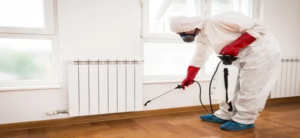Identifying the pest, finding out what’s attracting it, and removing food, water, and shelter can discourage them. So, hiring the right pest control company can be a good idea.
Pest control goals include prevention, suppression, and eradication. The goal is to reduce the number of pests to below an unacceptable level without harming humans or property. Click https://pezzpestcontrol.com/ to learn more.

Pest infestations can damage property and pose health risks for people and pets. They may also contaminate food and cause sanitation problems. Hiring a professional to identify and create a plan to stop pests from spreading can prevent them from damaging your home or business. A professional can find the best method to eliminate them for good, such as sealing gaps or using traps or spraying chemicals.
Prevention involves preventing pests from accessing food, shelter and water sources. It starts with a thorough inspection of the property by a trained technician, who will look for entry points, nesting areas and signs of pest activity. A tailored treatment plan is then created, taking into account the pest type and severity of the infestation. This plan can include both interior and exterior treatments, depending on the situation.
Preventing pests requires a combination of tactics, including limiting their food sources, restricting their access to water and altering the environment. Many pests are attracted to crumbs, and keeping counters, sinks and floors clean and free of crumbs can help keep pest populations low. Trash cans can also feel like an all-you-can-eat buffet to pests, so it’s important to empty and clean trash bins often.
Regular landscaping maintenance removes weeds, overgrowth and other hiding places where pests can hide. In some situations, it’s necessary to trim or prune shrubs and bushes so they don’t touch the building. This can also prevent rodents, ants, and other pests from creating pathways into the structure.
It’s also important to eliminate standing water sources, such as puddles and ponds. These can attract mosquitoes, flies and other insect pests that are harmful to people and animals. Fixing leaking pipes and faucets, removing piles of wood, and cleaning up rotting or mulch can also reduce the chance of pests moving into your home or business.
Pests are able to exploit the smallest cracks and crevices, so it’s important to regularly inspect and seal entry points. Tight-fitting doors, window seals and caulking can stop rats and mice from entering your home, and fixing loose screen windows and door frames keeps cockroaches out.
Suppression
Pests damage crops, cause diseases, and disrupt the natural order. They also contaminate food and make allergies and asthma worse. As a result, preventing pest infestations is crucial for health and well-being. Individuals may be able to deal with the odd ant hill in the garden or fly in the house, but it is usually professional pest controllers who carry out pest control on commercial premises. They can be local council pest controllers or one of the 878 commercial pest control services companies operating across the UK.
The first step in a pest control strategy is an inspection of the property. A trained technician will look for entry points, nesting areas and signs of pest activity. A customized treatment plan will then be devised based on the findings of the inspection. This treatment plan can include spraying, baiting, trapping and dusting. It will vary depending on the type of pest and the severity of the infestation.
Regular follow-up visits are vital to monitor the effectiveness of a treatment plan and prevent future outbreaks. These visits will also allow the pest controller to address any new pest problems as they arise. Biological methods are sometimes used as an alternative to chemical controls. For example, the pheromones that attract male and female insects can be manufactured and introduced to an area to reduce or eliminate the insect population. This technique works by interrupting the mating cycle and preventing reproduction.
Other biological methods involve introducing predators to an area to destroy pest populations. The use of genetically modified organisms (GMO) is another option for reducing pest populations. These organisms are engineered to resist certain diseases, and can be released into the environment to kill or repel specific pests.
Environmental factors such as climate and the availability of water can affect pest populations. Mountains and large bodies of water act as barriers to pests, restricting their movement and growth. The available food supply and shelter can also impact pests. For example, cockroaches thrive in moist environments where there is easy access to food and water. Cockroaches are known to spread a wide range of diseases and are considered to be among the filthiest insects in existence.
Eradication
If pests have reached a threshold level that is unacceptable in terms of damage or threat to humans, plants or pets, it may be necessary to eradicate them. The dictionary definition of eradication is “to uproot or destroy completely.” However, the term has been interpreted in many different ways in the context of pest control. Some pest control professionals use the term to mean complete destruction of a species, while others consider it to be more appropriate to focus on reducing the population to an acceptable level and not eradicate it entirely.
There are a number of approaches to eradicating pests, including the use of biological methods. These involve introducing other organisms to the environment that are natural predators or parasites of a particular pest, thus lowering the number of the unwanted insects. Examples include using nematodes, which are microscopic roundworms that can be sprayed onto soil to kill the fleas, grubs and ants that attack crops.
Other options for eradicating pests are insecticides, fumigants and baits. These can be used indoors or outdoors, depending on the type of pest. It’s important to select the right product and to follow label instructions. In addition, it’s a good idea to write down the name and EPA registration number of any chemical that is used in your home so that you can check its safety status and read its material safety data sheet.
Preventing pest infestations is the best way to protect your family and property from health and damage concerns. Sealing cracks and crevices, repairing leaks, improving ventilation, removing moisture sources and keeping foliage trimmed are important steps that can be taken to keep pests out of your house. If pests do enter your home, a professional can help you select the most effective treatment. Early detection and effective treatment can also save you money by preventing more severe problems down the road.
Monitoring
A pest control program must include monitoring to provide a reliable picture of the extent and severity of a pest problem. It helps determine whether a pest can be tolerated or controlled, and what methods are most effective. A well-designed monitoring program should include identifying and recording pests as they are discovered, and evaluating the results of any control actions taken.
Monitoring includes a variety of activities, including trapping and scouting. Monitoring also includes determining the damage caused by a pest and how it is affecting an area or crop, and may involve checking environmental factors such as temperature, moisture, and light levels. Monitoring may be done by pest managers or by other people at a facility, such as custodians or students. In schools, for example, asking teachers and students to regularly record their observations in a log is monitoring.
Some pests can be monitored using common household items such as a flashlight and an extendable mirror that allows inspection behind furniture and in secluded areas. A magnifying lens can help inspect for pest parts and frass (excrement). A sleeved bug trap is another inexpensive monitor that is easily set in the field. Professionals use a wide variety of monitors, including insect light traps and pheromone traps.
The most important tool of all is a trained eye. Observing what is happening in a field, garden, landscape, or building, and correctly identifying the pest is the most important aspect of monitoring. A trained pest control technician can help evaluate the situation and decide on the best course of action.
Once a pest is identified, the next step is to assess how severe the problem is and what the consequences of controlling it will be for human health and the environment. Using the information from monitoring and considering the biology of the pest, the environment, and other influences, the pest management professional can decide on an appropriate control strategy.
Integrated pest management, or IPM, is an ecosystem-based approach to managing the pest population and its damage through a variety of techniques including biological control, habitat manipulation, modification of cultural practices, resistance management, and pesticide application only when necessary. IPM uses the least hazardous control materials and applies them in a manner that minimizes risks to humans, beneficial organisms, and the environment.








